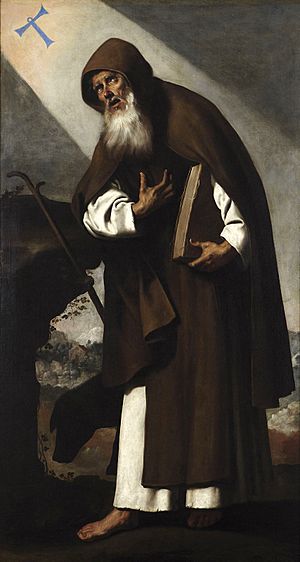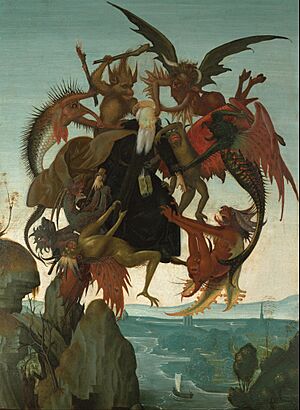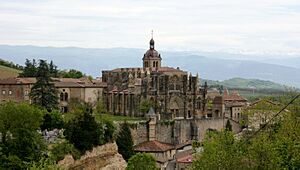Anthony the Great facts for kids
Quick facts for kids SaintAnthony the Great |
|
|---|---|

San Antonio Abad, portrait by Francisco de Zurbarán in 1664
|
|
| Venerable and God-bearing Father of Monasticism Father of All Monks |
|
| Born | 12 January 251 (reputedly) Herakleopolis Magna, Egypt |
| Died | 17 January 356 (aged 105) Mount Colzim, Egypt |
| Venerated in | Assyrian Church of the East Eastern Orthodox Church Oriental Orthodox Churches Catholic Church Anglican Communion Lutheranism (ELCA) |
| Canonized | Pre-Congregation |
| Major shrine | Monastery of St. Anthony, Egypt Saint-Antoine-l'Abbaye, France |
| Feast | 17 January (Catholic Church, Eastern Orthodoxy, Anglican Communion), Lutheranism (ELCA) 22 Tobi (Coptic Calendar) |
| Attributes | bell; pig; book; Tau Cross Tau cross with bell pendant |
| Patronage | Animals, skin diseases, farmers, butchers, basket makers, brushmakers, gravediggers, Pontifical Ecclesiastical Academy, Rome |
Anthony the Great (born around 251 AD, died 356 AD) was a Christian monk from Egypt. He is honored as a saint after his death. People call him by many names, like Anthony of Egypt or Anthony the Hermit. He is also known as the Father of All Monks because he was so important to Christian monasticism (a way of life where people live apart from society to focus on religious devotion).
His life story, written by Athanasius of Alexandria, helped spread the idea of Christian monasticism, especially in Europe. While he wasn't the very first Christian monk, Anthony was one of the first to go live alone in the desert around 270 AD. This made him very famous. Stories about him facing challenges in the desert have inspired many artworks and books.
People often pray to Saint Anthony for help with skin diseases. In the past, some skin problems were even called "Saint Anthony's fire." His feast day is celebrated on January 17th.
Contents
His Life Story
Most of what we know about Anthony comes from a book called Life of Anthony. Athanasius of Alexandria wrote it in Greek around 360 AD. The book shows Anthony as a simple, holy man who felt very connected to God by living in the wilderness.
This book became very popular. It was translated into Latin before 374 AD, which helped it become one of the most famous Christian books during the Middle Ages. It was translated into many languages and helped spread the idea of an "ascetic" life. An ascetic life means living a very simple life, often giving up comforts, to focus on spiritual goals.
The book inspired many monks in both the East and West. It played a big part in spreading Christian monasticism. Many stories about Anthony are also found in the Sayings of the Desert Fathers. Anthony probably spoke only Coptic, his native language. His sayings were later translated into Greek. He also wrote letters in Coptic, and seven of them still exist today.
Anthony's Journey
Early Life
Anthony was born in a place called Koma in Egypt. His parents were wealthy landowners. When he was about 20 years old, his parents passed away. This left him to care for his unmarried sister.
Soon after, he decided to follow a teaching from the Bible: "If you want to be perfect, go, sell what you have and give to the poor, and you will have treasures in heaven." Anthony gave some of his family's land to his neighbors. He sold the rest of his property and gave the money to the poor. Then, he left to live a simple, ascetic life. He placed his sister with a group of Christian women who had dedicated their lives to God.
Living as a Hermit
For the next 15 years, Anthony stayed in the area. He spent the first few years learning from another local hermit (someone who lives alone for religious reasons). Some stories say he worked as a swineherd during this time.
Anthony is sometimes seen as the first monk, or the first to live alone in the desert. However, there were others who lived simple, isolated lives before him. Anthony was special because he decided to go even deeper into the desert. He went to the Nitrian Desert, about 95 kilometers (59 miles) west of Alexandria. He lived there for 13 years.
Anthony ate a very strict diet. He only ate bread, salt, and water. He never ate meat or drank wine. He ate only once a day, and sometimes he would fast (not eat) for two or even four days.
According to Athanasius of Alexandria, the devil tried to bother Anthony with boredom, laziness, and visions of women. But Anthony overcame these challenges through prayer. This idea became a popular theme in Christian art. After this, Anthony moved to some tombs near his village. The Life book says he had strange fights with demons there. These demons appeared as wild animals and sometimes left him almost dead.
After 15 years of this life, when he was 35, Anthony decided to live in complete solitude. He went into the desert to a mountain by the Nile River called Pispir. He lived strictly enclosed in an old abandoned Roman fort for about 20 years. People would throw food to him over the wall. He usually refused to see visitors. But gradually, many people who wanted to be his students settled in caves and huts around the mountain.
This formed a group of ascetics. They begged Anthony to come out and guide them in their spiritual lives. He finally agreed around the year 305 AD. Everyone was surprised to see him. He looked healthy in mind and body, not thin or weak.

For five or six years, he taught and organized the many monks who had gathered around him. But then he went back into the deeper desert, between the Nile and the Red Sea. He settled on a mountain called Mount Colzim. A monastery that still bears his name, Der Mar Antonios, stands there today. He spent the last 45 years of his life there. This seclusion was not as strict as before. He freely saw visitors and often traveled across the desert to Pispir. During the Diocletian Persecutions (a time when Christians were punished), around 311 AD, Anthony went to Alexandria. He was seen visiting those who were in prison.
Father of Monks
Anthony was not the very first ascetic or hermit. But he is rightly called the "Father of Monasticism" in Christianity. This is because he organized his followers into a community. Later, Athanasius's book about him inspired similar communities all over Egypt and beyond. Macarius the Great was one of Anthony's students.
People traveled long distances to see the famous holy man. Anthony is said to have spoken to those who were spiritually minded. He left the task of talking to more worldly visitors to Macarius. Macarius later started his own monastic community in the Scetic desert.

Anthony's fame spread and even reached Emperor Constantine. The Emperor wrote to Anthony, asking for his prayers. The monks were happy about the Emperor's letter. But Anthony was not overly impressed. He wrote back, telling the Emperor and his sons not to value this world too much, but to remember the next.
Stories about Anthony meeting Paul of Thebes are well-known. One story tells of a raven bringing them bread. Another tells of Anthony being sent to get a cloak from "Athanasius the bishop" to bury Paul's body. Paul died before Anthony returned. These are famous legends from the Life book. However, people believed Paul existed even before the Life was written.
In 338 AD, Anthony left the desert for a short time. He visited Alexandria to help argue against the teachings of Arius, which were different from common Christian beliefs.
His Last Days
When Anthony felt he was going to die, he told his students to give his staff to Macarius of Egypt. He also told them to give one sheepskin cloak to Athanasius of Alexandria and another to Serapion of Thmuis, who was his student. Anthony was buried, as he had asked, in a grave next to his cell.
Challenges in the Desert

Stories about Anthony facing unusual challenges during his time in the desert have inspired many artworks and books. These challenges are often called "temptations."
Anthony is said to have faced many such temptations during his journey in the desert. His friend Athanasius of Alexandria was the first to write about them. It's possible these events, like the paintings, are rich with deeper meaning. Or perhaps they were visions or dreams. These stories became very popular in the Middle Ages.
Many artists have shown these events from Anthony's life. These include Martin Schongauer, Hieronymus Bosch, and Salvador Dalí. The writer Gustave Flaubert also retold and added to the story in his book The Temptation of Saint Anthony.
The Satyr and the Centaur
Anthony was traveling in the desert to find Paul of Thebes. He had a dream that Paul was a better hermit than he was. Anthony had thought he was the first person to live in the desert. But his dream told him to find Paul, his "better." On his way, he met two strange creatures: a centaur and a satyr. People at the time sometimes wondered if these were real beings. But Christian thinkers usually saw them as demons (evil spirits).
While traveling, Anthony first met the centaur. This creature was "half horse, half-man." Anthony asked for directions. The creature tried to speak in a strange language, but it pointed the way with its hand. Then it ran off and disappeared. This was seen as a demon trying to scare him, or perhaps a creature born from the desert itself.
Next, Anthony found the satyr. This was "a small man with a hooked nose, horned forehead, and feet like a goat's." This creature was peaceful and offered him fruits. When Anthony asked who he was, the satyr replied, "I am a mortal being and one of those desert dwellers whom people, tricked by mistakes, worship as Fauns, Satyrs, and Incubi. I am sent to represent my kind. We ask you to pray for us to your Lord and ours. We have learned that He came once to save the world, and 'His message has gone out to all the earth.'"
Hearing this, Anthony was very happy. He rejoiced about the glory of Christ. He criticized the city of Alexandria for worshipping monsters instead of God, while even creatures like the satyr spoke about Christ.
Silver and Gold
Another time, Anthony was traveling in the desert. He found a plate of silver coins on his path.
Demons in the Cave
Once, Anthony tried to hide in a cave to escape the demons that bothered him. But there were so many small demons in the cave that they beat him almost to death. Anthony's servant had to carry him out. When the hermits gathered around Anthony's body to mourn, Anthony woke up. He told his servants to take him back to the cave where the demons had beaten him. When he got there, he called out to the demons. They came back as wild beasts, ready to tear him apart.
Suddenly, a bright light flashed, and the demons ran away. Anthony knew the light must have come from God. He asked God where He was before, when the demons attacked him. God replied, "I was here, but I wanted to see your battle. And because you fought bravely and well, I will make your name known throughout the world."
Honoring Saint Anthony
Anthony was secretly buried on the mountain where he lived. His remains were reportedly found in 361 AD and moved to Alexandria. Later, they were taken from Alexandria to Constantinople to protect them from invading Saracens. In the 11th century, the Byzantine emperor gave them to a French Count named Jocelin. Jocelin had them moved to La-Motte-Saint-Didier, which was later renamed. There, Jocelin planned to build a church for the remains, but he died before it started. The church was finally built in 1297. It became a place of worship and pilgrimage, known as Saint-Antoine-l'Abbaye.
Anthony is believed to have helped with many miraculous healings, especially from a disease called ergotism. This disease became known as "St. Anthony's Fire." Two local noblemen said he helped them recover from the illness. They then founded the Hospital Brothers of St. Anthony in his honor. This group specialized in caring for people with skin diseases.
The Order of Saint Paul the First Hermit especially honors Anthony. This is because of his close connection with St. Paul of Thebes, after whom their order is named. In the Life of St. Paul the First Hermit, it says that St. Anthony found St. Paul near the end of his life. Without Anthony, Paul might not be known today.

In the East, Anthony is honored in a more quiet way. There are fewer icons and paintings of him. However, he is seen as the "first master of the desert and the greatest of holy monks." Some monastic groups of the Maronite, Chaldean, and Orthodox churches say they follow his monastic rules. During the Middle Ages, Anthony was honored as one of the Four Holy Marshals in the Rhineland area, along with other saints.
The Anglican Communion remembers Anthony with a special day called a Lesser Festival on January 17th.
Even though Anthony himself didn't create a formal monastery, a community grew around him. This community was based on his example of living a simple and isolated life. Athanasius's biography helped spread Anthony's ideas. Athanasius wrote, "For monks, the life of Anthony is a good example of asceticism." His story also influenced the conversion of important figures like Augustine of Hippo and John Chrysostom.
Coptic Writings
Some of the earliest original writings in the Coptic language were letters by Anthony. During the 3rd and 4th centuries, many church leaders and monks wrote in Coptic. Examples of purely Coptic literature include the works of Anthony and Pachomius, who only spoke Coptic. Also, the sermons of Shenouda the Archmandrite, who chose to write only in Coptic.
See Also
 In Spanish: Antonio Abad para niños
In Spanish: Antonio Abad para niños
- Mount Colzim, Anthony's "Inner mountain"
- Coptic Saints
- Abba Anoub of Scetis
- Chariton the Confessor (mid-3rd century – c. 350), a monk who lived around the same time in the Judaean desert
- Desert Fathers and Desert Mothers, early Christian hermits, ascetics, and monks who lived mainly in the Scetes desert of Egypt starting around the third century AD
- Abba Or of Nitria
- Hilarion (291–371), a hermit and saint considered by some to be the founder of monasticism in Palestine
- Monastery of Saint Anthony, Egypt
- Pachomius the Great (c. 292 – 348), an Egyptian saint often recognized as the founder of Christian communities where monks live together
- Patron saints of ailments, illness and dangers
- Paul of Thebes (c. 226/7 – c. 341), known as "Paul, the First Hermit," who lived before both Anthony and Chariton
- St. Anthony Hall, American fraternity and literary society
- Saint Anthony the Great, patron saint archive
- Serapion of Thmuis, a student of Anthony
- Pitirim of Porphyry, a student of Anthony
Images for kids
-
Painting of Saint Anthony, a part of The Visitation with Saint Nicholas and Saint Anthony Abbot by Piero di Cosimo, around 1480
-
Four tales on Anthony the Great by Vitale da Bologna, around 1340
-
A copy by the young Michelangelo after an engraving by Martin Schongauer around 1487–1489, The Torment of Saint Anthony. This is one of many artworks showing Saint Anthony's struggles in the desert.
-
Saint-Antoine-l'Abbaye, Isère, France









